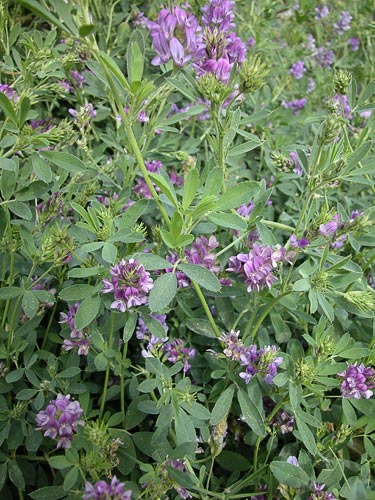Relatives
Medicago sativa L. - Lucerne, alfalfa, common purple Lucerne, common Lucerne, purple alfalfa, purple medick.
Taxonomic position.
Family Leguminosae Endl., genus Medicago L., subgenus Falcago (Reichb.) Grossh.Synonyms.
Medicago varia Mart., Medicago media Pers.Biology and morphology.
Perennial plant with a medium-length lifespan. Alfalfa is basically a tap-rooted plant that may penetrate the soil to a depth of 4 m or more. The stems grow erect and reach a height of 40-90 cm. The leaves are arranged alternately on the stem and are pinnately trifoliate; leaflets are 30 mm long, narrowly obovate or linear, toothed in upper third with a munconate tip; stipules linear-lanceolate, usually serrated. Inflorescences are compact racemes, 10-25 mm long, borne in axils of upper leaves; florets range in color from yellow to blue and purple, 8 mm long, typically papilionacious. Seed pods spirally coiled, glabrous or pubescent; pods change from green to brown as they mature and contain 3-5 kidney-shaped, yellow or brown seeds. A proportion of the seeds is hard. Cross-pollinated by various species of bees. Blossoms in May-July; seeds ripen in July-September. 2n = 16, 32.Distribution.
Widely distributed throughout temperate zones of the world, e.g. Europe, China, southern Latin America, South Africa, Afghanistan, Iran, the European part of the former USSR, the Crimea, the Caucasus, Western Siberia, Kazakhstan, and Asia Minor.Ecology.
Occurs in meadows, along the edges of forests, among bushes, on riversides, along roadsides, and on hillsides. Well-adapted to a wide range of climatic and soil conditions but grows best in deep, loamy soils that are well-drained. Relatively drought tolerant but does not grow well in highly alkaline soils.Utilization and economic value.
Introduced into cultivation (highest yielding forage legume). Characterized by high ecological plasticity. Responds to irrigation and soil fertility. Used in breeding programs as a donor of valuable traits (salt resistance, winter hardiness, seed productivity, and so on). Characterized by high nitrogen content due to symbiosis with Sinorhizobium medicae.Literature cited:
Brezhnev D.D., Korovina O.N. 1980. Wild relatives of the cultivated plants of flora of the USSR. L.: Kolos, 376 pp. (in Russian).Galushko A.I. 1980. Flora of the Northern Caucasus. A field guide. Vol. 2. Rostov-na-Donu, 350 pp. (in Russian).
Goncharov P.L., Lubenetc P.A. 1985. Biological Aspects of Alfalfa Cultivating. Novosibirsk: Nauka, 253 pp. (in Russian).
Grossheim A.A. 1952. Genus Medicago. Flora of the Caucasus. Vol. 5. M.-L.: Academy of Science of the USSR, p. 177-192. (in Russian).
Grossheim A.A. 1945. Genus Medicago. Flora of the USSR. Vol. 11. M.-L.: USSR, p. 129-176. (in Russian).
Ivanov A.I. 1980. Alfalfa. M.: Kolos, 349 pp.
Ivanov A.I., Soskov U.D., Bukhteeva A.V. 1986. Resources of perennial fodder crops in Kazakhstan. Alma-Ata: Kainar, 219 pp.
Khasanov O.H. 1972. Wild species of Alfalfa in Asia Minor. Tashkent: Fan, 170 pp. (in Russian).
Lesins K.A., Lesins I. 1979. Genus Medicago (Leguminosae). A Taxogenetic study, 228 pp.
Nikitin V.V., Geldikhanov A.M. 1988. Plants of Turkmenistan. A field guide. L.: Nauka, 680 pp. (in Russian).
Ovchinnikov P.N., ed. 1978. Flora of Tajikistan. Vol. 5. L.: Nauka, 678 pp. (in Russian).
Pavlov N.B., ed. 1961. Flora of Kazakhstan. Vol. 5. Alma-Ata: AN KazSSR, 515 pp. (in Russian).
Phyodorov A.A., ed. 1987. Flora of the European part of the USSR. Vol. 6. 254 pp. (in Russian).
Polozhiy A.B., Malyshev L.I., eds. 1994. Flora of Siberia. Vol. 9. Novosibirsk: Nauka, 280 pp. (in Russian).
Schischkin V.K., Bobrov E.G., eds. 1945. Flora of the USSR. Vol. 11. M.-L.: USSR, p. 129-176. (in Russian).
Sinskaya E.N. 1948. Species dynamics. M.-L.: Selhozgiz, 526 pp. (in Russian).
Sinskaya E.N. 1950. Alfalfa. Flora of cultivated plants of the USSR. Vol. 13. M.-L.: Issue 1, p. 1-344. (in Russian).
Vasil.chenko I.T. 1949. Alfalfa as the best fodder crop. L.: Academy of Science of the USSR. Ser. 1, Issue 8, 248 pp.
Vvedenskiy A.I., ed. 1981. Plants of Asia Minor. A field guide. Vol. 6. Tashkent: Fan, 394 pp. (in Russian).


